
Quick Specs
Architecture: Intel 586
CPU: One Intel Pentium @ 60/75/90/100/120/133MHz, 256K cache
Video: S3 Trio32 (60MHz?) or Trio64 (75Mhz+)
RAM: 4MB (60MHz) or 8MB (75Mhz+) onboard, 128MB maximum
Chassis: low-profile / full-profile desktop
Bus: low-profile: 1* PCI, 1* ISA, 1* PCI/ISA (shared)
Operating System: Windows for Workgroups 3.11, Windows 95 ready
Digital Venturis 5xxx
The Venturis line started in November 1994 with 486 and 60MHz Pentium models,
with 75MHz+ models with better onboard graphics and increased onboard memory
following in May 1995 starting at US$1899 (US$3796 in 2023). It was available
in desktop form only, coming in either a low-profile or full-profile case.
One of these (not the one pictured) was the first computer I ever purchased
myself (second-hand) at age 12. That machine had a CD-ROM drive, and came with
the pictured keyboard and mouse but not the CRT - that came from somewhere else
at a much later date.
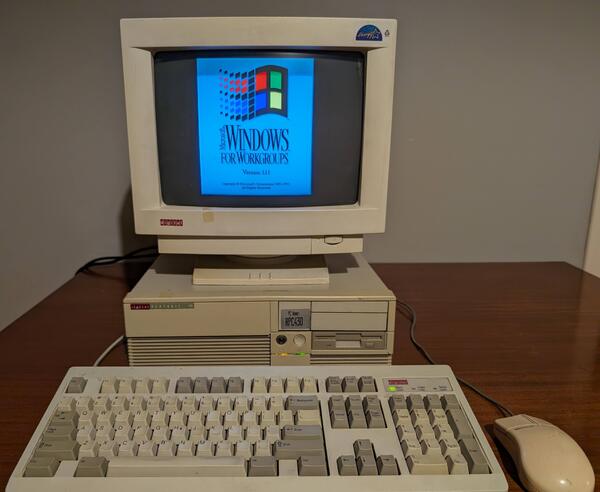
The case on these machines is fairly easy to work with despite its compact nature.
Latches on both sides fold out and twist to slide the top cover off (provided the
key lock on the front has been unlocked), and the drives and power supply tilt out
to the side to provide access to the motherboard and two internal 3.5" hard disk
bays.
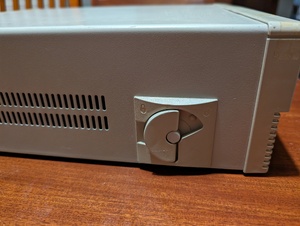
The case also appears to be very closely related to that of the Olivetti M4-75S. The
metal frame complete with tilting drive bays and PSU appears to be identical, with the
Venturis just having different front/rear/side plastic components.
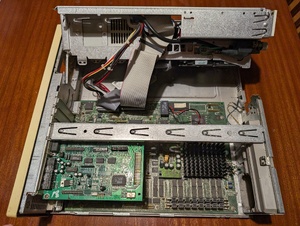

While the case may have come from Olivetti, the motherboard is quite clearly from DEC.
There are at least three variants of the Pentium motherboard - the earlierst 560 model
with half the RAM and graphics, the v1.0 model (below, left), and the v2.0 model
(below, right) with the VRM moved off of a module and on to the motherboard and an additional
two memory slots. The v2.0 motherboard supports CPU speeds up to 200MHz and EDO Memory, while the v1.0
board is limited to 133MHz and FPM Memory (unless you have the Venturis 575 E or similar with onboard EDO).
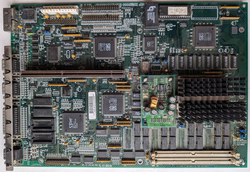
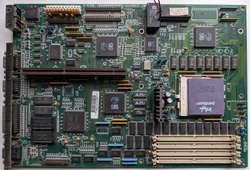
RTC Chip
These systems use a Dallas DS12887 or compatbile real time clock (RTC) module over near
the IDE connectors. When the battery built in to this module runs flat the system
will loose its settings and may get strange defaults. If the battery runs completely
flat the system may reboot before completing POST or on entering the BIOS. The solution
is to either replace the RTC module with a brand new one from a reputable source,
or use a dremel and a soldering iron to disconnect the modules internal battery and connect
a battery holder with a fresh battery.
In The Collection
| Name |
Model |
RAM |
CPU |
HDD |
CD-ROM |
Cards |
Condition/notes |
|
575 |
8MB |
75MHz |
— |
— |
— |
Not working (keyboard controller failure) 22/01/2024. Motherboard corrosion near PS/2 port (rodent damage). No FDD or 5.25" tray.
Built October 1995. Model 920WW. Purchased second-hand in 1999. Inventory: COMP-0006 |
|
575 |
8MB |
75MHz |
— |
— |
— |
Unknown. Built July 1995. Model 920WW. No FDD or 5.25" tray. No RTC chip. |
|
575 |
24MB |
75MHz |
428MB |
— |
ESS1688 ISA Sound
RTL8019 ISA NIC |
Working with new DS12887 battery 22/01/2024. Has hard drive and likely sound card & RAM from the 1999 machine. 5.25" bay is blanked.
Built July 1995. Model 920WW. S/N TA530P8636. Acquired from Hort+research mid-2002. |
|
5133 |
8MB |
133MHz |
— |
Mitsumi 8x |
— |
Working with new DS12887 battery 21/04/2024. CD-ROM installed 20/04/2024.
Rear plastic is cracked around the top screws.
Version 2.0 motherboard. Has additional VRAM installed. Model FR-928AZ-00. Inventory: COMP-0008
|
Documentation & Drivers

Other Links







